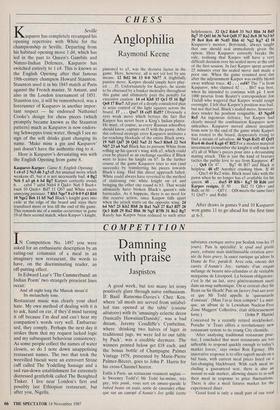CHESS
Anglophilia
Raymond Keene
KSeville asparov has completely revamped his opening repertoire with White for the championship in Seville. Departing from his habitual opening move 1 d4, which has led in the past to Queen's Gambits and Nimzo-Indian Defences, Kasparov has switched entirely to 1 c4. This is known as the English Opening after that famous 19th-century champion Howard Staunton. Staunton used it in his 1843 match at Paris against the French master, St Amant, and also in the London tournament of 1851. Staunton too, it will be remembered, was a forerunner of Kasparov in another impor- tant respect — he endorsed Nathaniel Cooke's design for chess pieces (which promptly became known as the Staunton pattern) much as Kasparov is now endors- ing Schweppes tonic water, though I see no sign of the soft drinks giant changing its name. 'Make mine a gin and Kasparov' just doesn't have the authentic ring to it.
Here is Kasparov's devastating win with the English Opening from game 8.
Kasparov-Karpov: Game 8; English Opening. 1 c4 e5 2 Nc3 d6 3 g3 c5 An unusual move which weakens d5, but it is not necessarily bad. 4 Bg2 Nc6 5 a3 g6 6 b4 Bg7 Karpov correctly avoids 6. . . cxb4 7 axb4 Nxb4 8 Qa4+ Nc6 9 Bxc6+ bxc6 10 Qxc6+ Bd7 11 Qb7 and White exerts annoying pressure. 7 Rbl Nge7 S e3 0-0 9 d3 Rb8 10 Nge2 Be6 11 b5 Na5 Black's knight goes into exile at the edge of the board and stays there transfixed more or less till the end of the game. This reminds me of a similar occurrence in game 19 of their second match, when Karpov's knight, pinioned to a5, was the decisive factor in the game. Here, however, all is not yet lost by any means. 12 Bd2 b6 13 0-0 Nb7? A frightfully passive move. Karpov should simply have play- ed .f5. Unfortunately for Karpov, he seems to be obsessed by a bunker mentality throughout this game and ultimately pays the penalty for excessive caution. 14 e4 Kh8 15 Qcl f5 16 Bg5 Qe8 17 Bxe7 All part of a deeply considered plan to seize control of the light squares across the board. 17 . . . Qxe7 18 exf5 BxfS? Obviously a very weak move which betrays the fact that Karpov has never been a King's Indian player. He must, of course, as every Russian schoolboy should know, capture on f5 with the pawn. After this colossal strategic error Kasparov institutes a far-reaching blockade of the entire Black army. 19 Nd5 Qd7 20 Qd2 Na5 21 Nec3 RbeS 22 Ne4 Nb7 23 a4 Na5 Black has to prevent White from rolling up his queen's wing with a5, which could even be played as an exchange sacrifice if Black were to leave his knight on b7. In the further course of the game Kasparov tries to win (and succeeds) by transferring his pieces towards Black's king. Had this direct approach failed, White could always have reverted to the method of stationing one white knight on e4 and bringing the other one round to b3. That would ultimately have broken Black's queen's side barricades. As it happens, there is no need for this reserve action, since Karpov falls apart when the attack starts on the opposite wing. 24 h4 Nb7 25 Kh2 Rb8 26 Ral Na5 27 Ra3 Rf7 28 Qc3 Rd8 29 Ra2 Bh6 30 Ng5 R7f8 31 Re2 Bg7 Rarely has Karpov been reduced to such utter
helplessness. 32 Qc2 RdeS 33 Ne3 Bh6 34 Bd5 Bg7 35 Qdl h6 36 Ne4 Qd8 37 Ra2 Bc8 38 Nc3 h5 39 Be4 Re6 40 NcdS Bh6 41 Ng2 Kg7 42 f4 Kasparov's mentor, Botvinnik, always taught that one should seal immediately given the option. Here Kasparov correctly breaks the rule, realising that Karpov will have a very difficult decision over his sealed move at the end of the first session. In fact Karpov spent around 25 minutes over his sealed move and made a poor one. When the game resumed next day after the adjournment Karpov was swiftly blown away without trace. 42 . . . exf4? The ? is from Kasparov, who claimed 42 . . . Bb7 was best, when he intended to continue with g4. I won 1000 pesetas from Reuter's correspondent Jon Tisdall who wagered that Karpov would resign overnight. I felt that Karpov's position was bad, but not that bad. Black's sealed move, however, does render his position resignable. 43 Ngxf4 Re5 An ingenious defence, but Karpov had clearly missed the combination Kasparov now unleashes. Kasparov moved almost instantly from now to the end of the game while Karpov was rooted to the board, desperately trying to find a means of salvation. 44 Nxg6 Rxfl 45 Qxfl Rxe4 46 dxe4 Kxg6 47 Rf2 For a modest material investment (remember the knight is still stuck on a5) all of White's pieces pour into a devastating mating attack. This is just the kind of bravura tactics the public love to see from Kasparov. 47 . . . Qe8 Or 47 . . . Bg7 48 Rf7 and Black is helpless. 48 e5! Another crushing blow. If 48 . . . Qxe5 49 Re2 wins. Black must take with the pawn when he no longer has e5 available for his queen. 48 . . . dxe5 49 Rf6+ Kg7 50 Rd6 and Karpov resigns. If 50 . . . Bd2 51 Qf6+ and Rd8, or 50 . . . Qf7 (. . Qf8 meets the same fate) 51 Qxf7+ and Rxh6.
After draws in games 9 and 10 Kasparov won game 11 to go ahead for the first time at 6-5.










































































 Previous page
Previous page